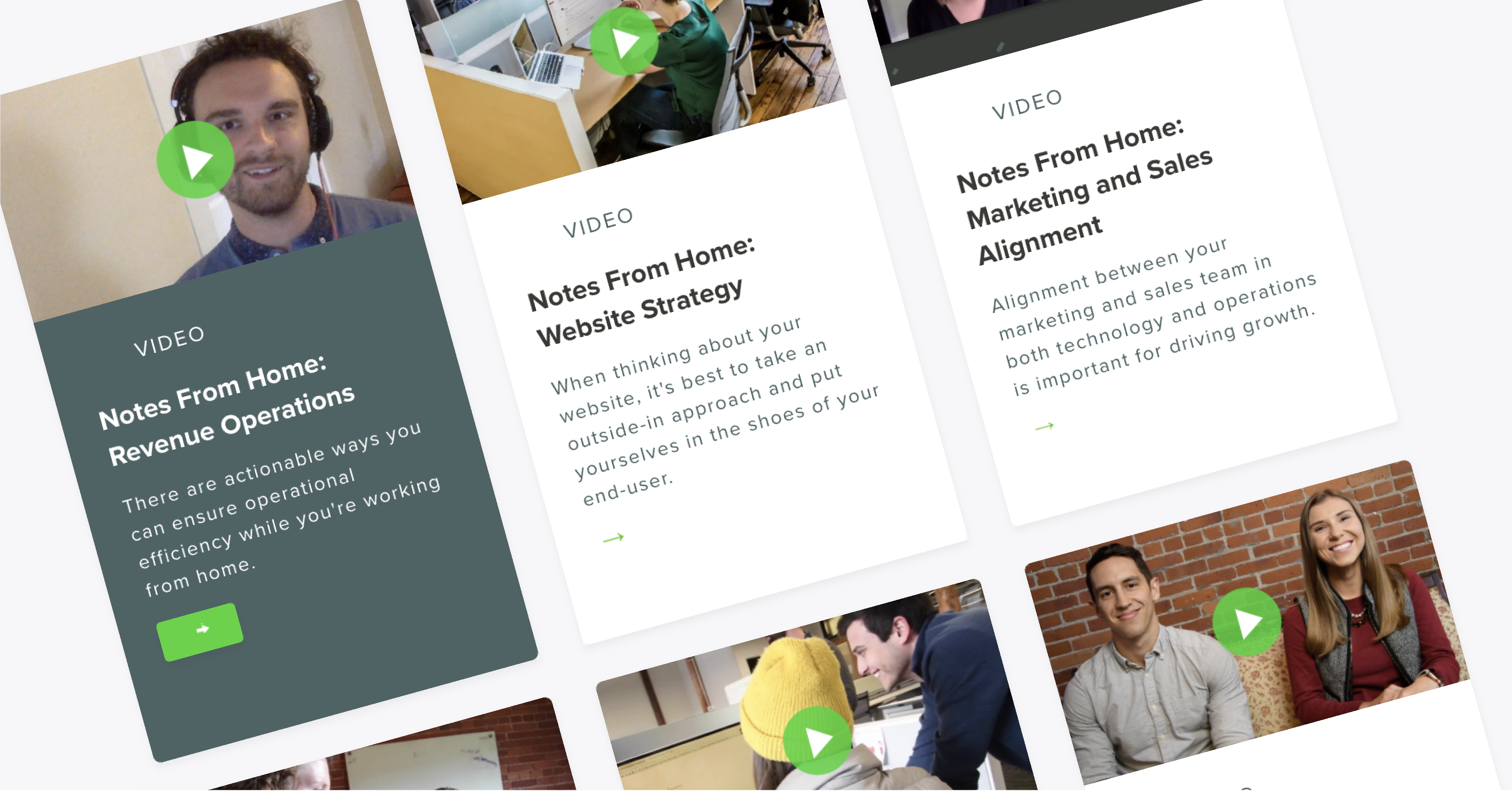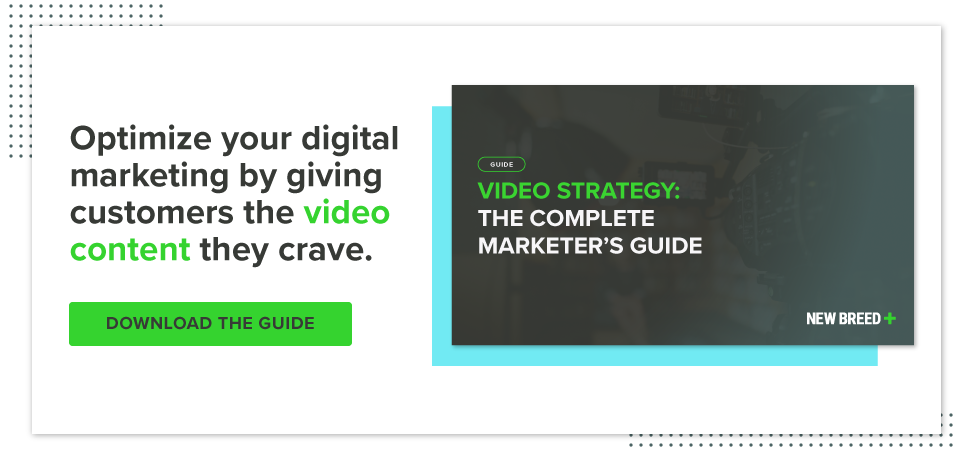How To Drive Conversions With Video Marketing

Video content can add enormous value to your marketing strategy, but it is often only seen as a brand awareness tactic. Taking the time to incorporate video content onto your website can increase its effectiveness at driving conversions. Not only does this benefit your ability to turn visitors into leads, but also your ability to measure the impact of your videos.
That’s why using video on landing pages and elsewhere on your website to encourage CTA clicks or form entries can be a great strategy. Leveraging video content across your website will enable you to better measure its impact on a prospect’s journey and maximize the return on the work it takes to create it.
Driving Conversions with Video
Fundamentally, the principle of using video to drive conversions on your website is the same as how you might use a blog post. Aligning your video content with a likely next step, offer or download will push visitors toward the ultimate goal of becoming a lead.
Align with your existing offers
Let’s say you write a blog post that explains questions to answer to improve your brand identity. That post would include calls-to-action to a relevant premium content offer about how to run a brand workshop.
You should apply the same approach when putting videos on landing pages. When developing your video strategy, consider your existing offers, nurture tracks and how to align your planned content with those offers. By being thoughtful about what content you’re lacking and how video can support your current efforts, you’re more likely to see better results both in your video analytics and conversion rate.
Create videos for every stage of the buyer’s journey
Beyond supporting your existing offers, you should also consider where your video content falls in the buyer’s journey. Testimonial videos and product demonstration videos make sense for the bottom of the funnel to drive a purchase, while how-to and explainer videos are strong top-of-funnel content that build brand awareness.
As you map out your video strategy and account for the offers you already have, consider how video can help push a prospect from one stage to the next. If you’re struggling with moving SQLs to opportunities, can you reach out to existing clients to create more testimonial videos? If yes, you can drive SQLs to landing pages with testimonial videos and a form to request an assessment or set a meeting with sales.
Capture attention right away
The first 15 seconds of your video are incredibly important. How are you grabbing the viewer’s attention? Do you spend more time on fancy intro graphics and theme music before getting into the content?
If a viewer is forced to wait for what they want to watch, they’ll be less likely to watch through your video and ultimately convert on the desired next step. Capture the viewer’s attention early and they’re less likely to drop off, enabling you to convince them to stay on-site and keep looking for more information.
Take length into account
There’s no hard-and-fast rule for your video length. How long your audience is willing to engage with your content can be dependent on your industry, the type of content and its general appeal. That said, consider how long people generally watch your videos or their average time spent on your website.
The longer your video, the more time a user spends watching versus converting. An exceptionally long video may even scare a viewer away. By erring on the side of caution and going shorter, you can convey your message and keep your viewer wanting more.
Consider the User Experience
While video content can be an effective tool to drive conversions on your website, it’s also important to take user experience into account when designing these conversion opportunities. I spoke with New Breed’s Senior Web Strategist Kelly Molloy to talk about best practices for using video on your website.
Prioritize accessibility
While statistics say more and more customers expect video in their buying process, not everyone will want to — or be able to — watch your videos. With that in mind, it’s important that you prioritize accessibility with all of your content.
To prepare for videos that may be viewed without sound, every video should include edited captions or transcripts. While many video hosts are capable of automatically generating captions for your videos, they are not perfect. You should edit captions before sharing your video across your website.
Don’t trick people into watching your video
If there are going to be visitors to your website that don’t want to watch videos, you should avoid tricking them into doing so. Any user should be fully aware that they are about to watch a video.
That means including play buttons on images that link out to videos or specifying when hyperlinks link out to video content — especially if the video will autoplay.
“You want to be really clear about what type of information your video is going to provide,” says Kelly. “How long the video is going to be, options to play, pause and control sound, these factors are important to the user experience.”
Giving the user control over the video also includes telling them how long a video will be and the time commitment on their end. These considerations give your users more control over their experience, but also enable them to re-engage with your content which is a great indicator of success.
Always have supporting content
While videos can be effective at driving conversions on your website, you cannot be overly reliant on them. As has been said, not everyone is going to watch your video. If users aren’t able to access content in a different way and don’t want to watch your video, you risk a visitor bouncing off of your site entirely.
“At a minimum, any essential information contained in the video should also be included on the page as written copy,” says Kelly.
This can be done when using videos on landing pages by ensuring the video isn’t alone on the page or by featuring videos in blog posts as an alternative to reading the written content.
Monitor your existing videos
Most marketers are leveraging some kind of video hosting platform such as Vidyard, YouTube or Vimeo to upload and share their videos on their website. Left unmanaged, these platforms can get messy. Videos can be deleted, moved or edited without updating embed codes wherever they are placed, leading to broken videos.
“How many times have you been on a site and seen a broken video?” asks Kelly. “Leaving dead ends or broken links on your website provides a negative user experience, so make sure you’re checking back in on that content over time.”
Keeping a well-organized hosting platform and monitoring your website for broken videos is vital for making sure users have a good experience and ensure that your video content is working for you rather than against you.
Additionally, you invest a lot of time and resources into creating video content. With that in mind, it is a general best practice to make your videos as evergreen as possible. You don’t want to have to update videos on a regular basis.
“If you’re leveraging video to educate prospects and in two years your platform or information changes, then you can really frustrate viewers looking at outdated content,” says Kelly.
Whenever you set out to create a new video, you should consider whether the information, the people featured or overarching concept is dated. If so, you need to establish a process for revisiting older video content and updating it or removing it entirely.
Takeaway
Video marketing can play a huge role in attracting visitors and nurturing them into leads. By creating a strategy that prioritizes content that drives conversions, you can use video to guide prospects from visitors to customers.
Like most things in marketing, driving conversions with video is a balance between goals and user experience. As you start to use video more and more on your website, it’s important to create and maintain a good user experience or you risk driving visitors away.
Chris Singlemann
Chris is a Brand Marketer at New Breed where he is responsible for crafting design and video assets that support our brand. When he's not behind the camera, he enjoys kayaking and tending to his sourdough starter.





